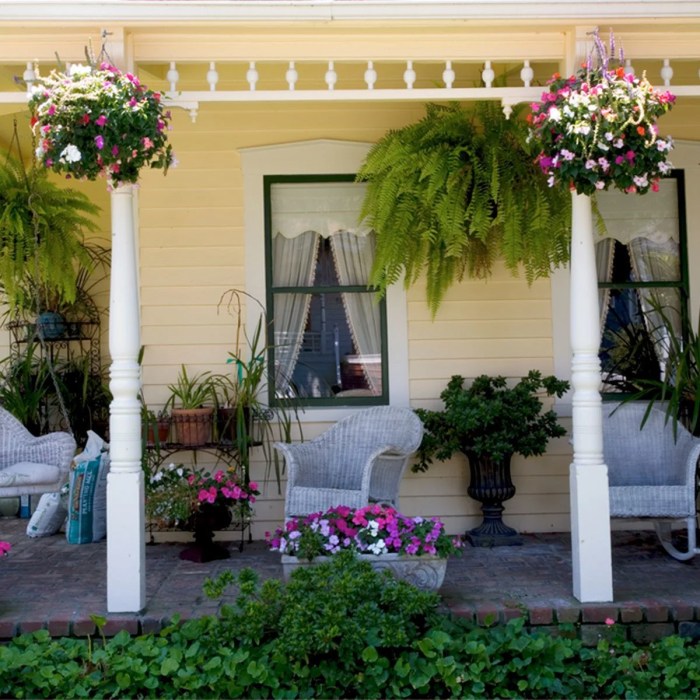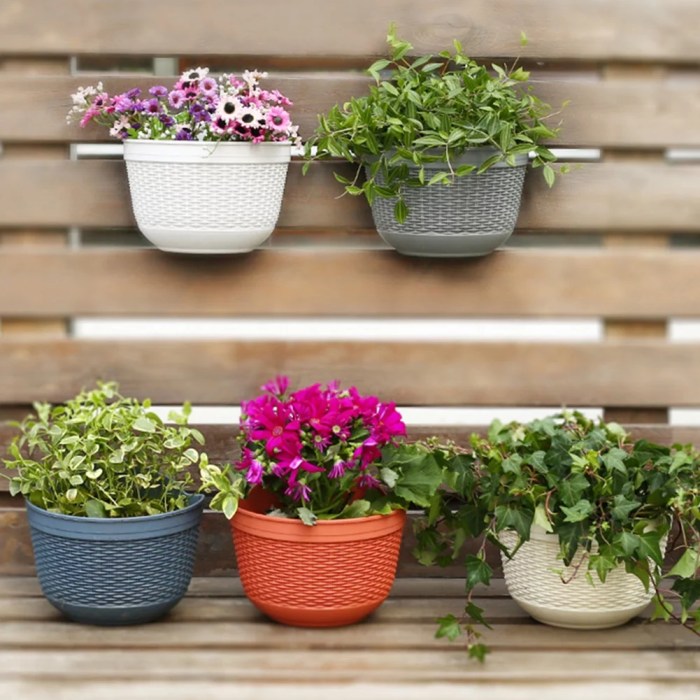10 hanging plants porch, a guide to enhance your outdoor space with lush greenery and vibrant blooms. From selecting the perfect plants to caring for them, this comprehensive guide will help you create a stunning porch oasis.
Hanging plants are a beautiful and practical way to add life and color to your porch. They can create a sense of privacy, filter sunlight, and even improve air quality. With so many different types of hanging plants to choose from, you’re sure to find the perfect ones to complement your porch décor.
Hanging Plant Varieties: 10 Hanging Plants Porch

Porches offer a welcoming space for relaxation and enjoyment, and hanging plants can add a touch of greenery and freshness to these outdoor havens. Here is a comprehensive guide to popular hanging plants suitable for porches, including their scientific names, common names, and unique characteristics.
These plants offer diverse foliage, growth habits, and flowering characteristics, making it easy to find the perfect addition to any porch decor.
Common Hanging Plants for Porches
- Spider Plant (Chlorophytum comosum): Known for its long, arching leaves with variegated patterns, spider plants are easy to care for and produce plantlets that can be propagated to create new plants.
- Pothos (Epipremnum aureum): Pothos is a versatile plant with trailing vines and heart-shaped leaves that come in a variety of colors, including green, yellow, and white.
- String of Pearls (Senecio rowleyanus): This unique plant features trailing stems adorned with small, bead-like leaves that resemble pearls.
- Burro’s Tail (Sedum morganianum): With its cascading stems and fleshy, cylindrical leaves, burro’s tail creates a dramatic effect when hung from a porch ceiling.
- Hoya (Hoya carnosa): Hoyas are known for their waxy, fragrant flowers that bloom in clusters. They prefer bright, indirect light and well-draining soil.
Porch Design and Plant Placement
When designing your porch and selecting hanging plants, it’s crucial to consider the porch’s size, sunlight exposure, and available hanging space. A well-planned arrangement can create a balanced and visually appealing atmosphere.
Maximize Vertical Space
To make the most of your porch space, utilize hanging baskets, macrame hangers, or wall-mounted planters. These options allow you to display plants vertically, freeing up floor space and creating a lush, cascading effect. Consider the height of the ceiling and the length of the hanging planters to ensure plants have ample room to grow and showcase their beauty.
Plant Care and Maintenance
Maintaining the health and beauty of hanging plants on your porch requires proper care and maintenance. Each type of plant has specific needs, so it’s essential to understand their individual requirements.
Whether you’re looking to add a touch of greenery to your porch or you’re looking for plants that are safe for your feline friends, there are plenty of options to choose from. 10 hanging plants not poisonous to cats are a great option for cat owners who want to enjoy the beauty of plants without worrying about their pet’s safety.
And with so many different varieties to choose from, you’re sure to find the perfect plants to complement your porch décor.
Watering
Hanging plants typically require more frequent watering than their counterparts on the ground. The frequency varies depending on the plant species, pot size, and weather conditions. Allow the soil to dry out slightly between waterings to prevent overwatering.
Fertilizing
Fertilize hanging plants every few weeks during the growing season with a balanced liquid fertilizer. Avoid over-fertilizing, as it can damage the plants.
Pruning
Regular pruning helps maintain the shape and size of hanging plants. Remove dead or damaged leaves and stems to encourage healthy growth.
For those seeking to create a vibrant and welcoming porch, consider incorporating hanging plants into the design. With their cascading foliage and lush greenery, hanging plants can add a touch of nature and tranquility to any outdoor space. While there are numerous options available, a selection of 10 hanging plants suitable for medium light conditions can provide a balance of aesthetics and ease of care.
To explore these options further, refer to the comprehensive guide on 10 hanging plants medium light , which offers valuable insights and recommendations for creating a captivating porch adorned with flourishing greenery.
Pest and Disease Management
Common pests that can affect hanging plants include aphids, mealybugs, and spider mites. Diseases such as powdery mildew and root rot can also be a problem. Inspect plants regularly for signs of pests or diseases and treat them promptly with appropriate methods.
Repotting and Grooming
As hanging plants grow, they may need to be repotted into larger containers. Repotting provides fresh soil and nutrients, while grooming helps remove dead leaves and stems, enhancing the plant’s appearance.
Seasonal Considerations

Hanging plants can enhance the beauty of your porch throughout the year. However, choosing plants that thrive in your local climate is essential. Here’s how to select hanging plants for different seasons and protect them from extreme weather conditions.
In areas with hot summers, opt for heat-tolerant plants like petunias, lantana, and begonias. These plants can withstand high temperatures and direct sunlight. In colder climates, choose hardy plants like pansies, violas, and ivy. These plants can tolerate frost and cold temperatures.
Protecting Plants from Extreme Weather
Protect your hanging plants from extreme heat by providing shade during the hottest part of the day. You can use a shade cloth or place the plants under a tree. During cold weather, wrap the pots with burlap or blankets to insulate the roots.
You can also move the plants indoors if possible.
Whether you’re looking to add a touch of greenery to your porch or simply create a more inviting space, hanging plants are a great way to do so. With their trailing vines and lush foliage, hanging plants can add a touch of life and color to any space.
If you’re looking for a plant that will thrive in a shady spot, consider one of these 10 hanging plants that don’t need a lot of light . From the trailing pothos to the delicate maidenhair fern, there are plenty of options to choose from.
And if you’re looking for a plant that will add a touch of color to your porch, consider one of these 10 hanging plants that bloom.
Seasonal Maintenance Tasks
Seasonal maintenance tasks for hanging plants include pruning, watering adjustments, and fertilizing. Prune dead or damaged leaves and stems to encourage new growth. Adjust watering frequency based on the season and weather conditions. Fertilize the plants regularly to provide essential nutrients.
Creative Display Ideas
Unlock the potential of your porch with innovative display ideas for hanging plants. These vertical gardens, privacy screens, and decorative accents will transform your outdoor space into a vibrant oasis.
Vertical Gardens
Maximize vertical space by creating lush vertical gardens. Suspend hanging planters from the ceiling or install trellises on walls. Layer plants with varying heights and textures to create a cascading effect.
Privacy Screens
Enhance privacy and define outdoor areas with hanging plants. Line the perimeter of your porch with dense, trailing plants, such as ivy or ferns, to create a natural barrier.
Decorative Accents, 10 hanging plants porch
Add a touch of elegance or whimsy with hanging plants used as decorative accents. Suspend colorful blooms or cascading greenery from beams or hooks to create eye-catching focal points.
Outcome Summary
With proper care and attention, your hanging plants will thrive and bring years of beauty and enjoyment to your porch. So what are you waiting for? Start creating your own hanging plant paradise today!
FAQ Resource
What are the best hanging plants for a porch?
Some of the best hanging plants for a porch include ferns, ivy, pothos, and succulents. These plants are all relatively easy to care for and can tolerate a wide range of light conditions.
How do I care for hanging plants?
Hanging plants need to be watered regularly, but be careful not to overwater them. They also need to be fertilized monthly during the growing season. Most hanging plants prefer bright, indirect light, but some can tolerate low light conditions.
How often should I repot hanging plants?
Hanging plants should be repotted every 2-3 years, or when they become rootbound. When repotting, use a potting mix that is specifically designed for hanging plants.